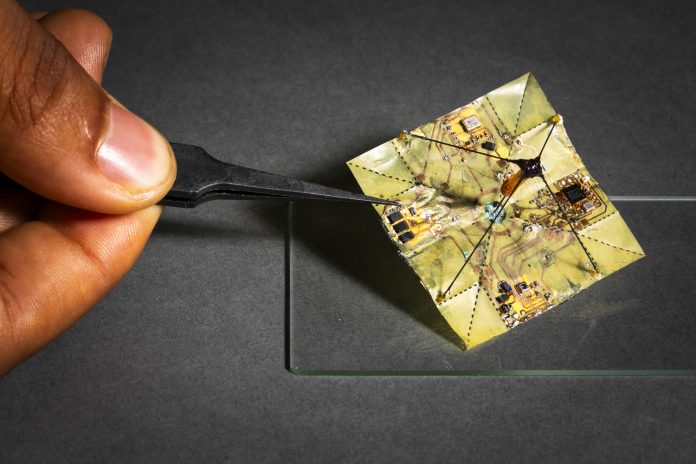Scientists from the University of Washington have created a compact battery-free robot capable of altering its flight path by quickly transitioning into a folding configuration during its descent, to mimic the flight of different leaf types in mid-air
When released from a drone, these “microfliers” allow the battery-free robot to ‘snap’ into a folded position. Using Miura-ori origami, the uses folding to shift from a tumbling, scattered state in the air to a direct descent towards the ground.
To disperse the fliers, the scientists managed the timing of each device’s transformation using several techniques: an onboard pressure sensor for altitude estimations, an onboard timer, or a Bluetooth signal.
Battery-free robots and microfliers
These microfliers weigh approximately 400 milligrams. They can cover the length of a football field when released from a height of 40 meters (approximately 131 feet), even in mild winds.
Each device has an onboard battery-free actuator, a solar power-harvesting circuit controlled to trigger these shape transformations while mid-air.
Moreover, these microfliers can accommodate onboard sensors for monitoring temperature, humidity and other environmental conditions during their flight.
Monitoring temperature, humidity, and other environmental conditions during their flight
The team published these results on September 13th in Science Robotics.
“We combine the Miura-ori fold, which is inspired by geometric patterns found in leaves, with power harvesting and tiny actuators to allow our fliers to mimic the flight of different leaf types in mid-air. In its unfolded flat state, our origami structure tumbles chaotically in the wind, similar to an elm leaf. This highly energy efficient method allows us to have battery-free control over microflier descent, which was not possible before.”
Robotic design challenges
These robotic systems have successfully addressed numerous design challenges; these devices:
- Maintain sufficient stiffness to prevent unintended transitions to the folded state before receiving the signal.
- Shift between states swiftly, with the onboard actuators requiring just around 25 milliseconds to trigger the folding process.
- Accomplish shape changes without being tethered to a power source. The microfliers rely on a power-harvesting circuit that utilises sunlight to supply energy to the actuator.
Future enhancements
The microfliers can only shift from tumbling to falling, allowing researchers to manage multiple microfliers’ descent simultaneously, causing them to scatter in various directions during their descent.
In the future, devices will be able to transition in both directions. This enhanced functionality will enable more accurate landings, particularly in turbulent wind conditions.











